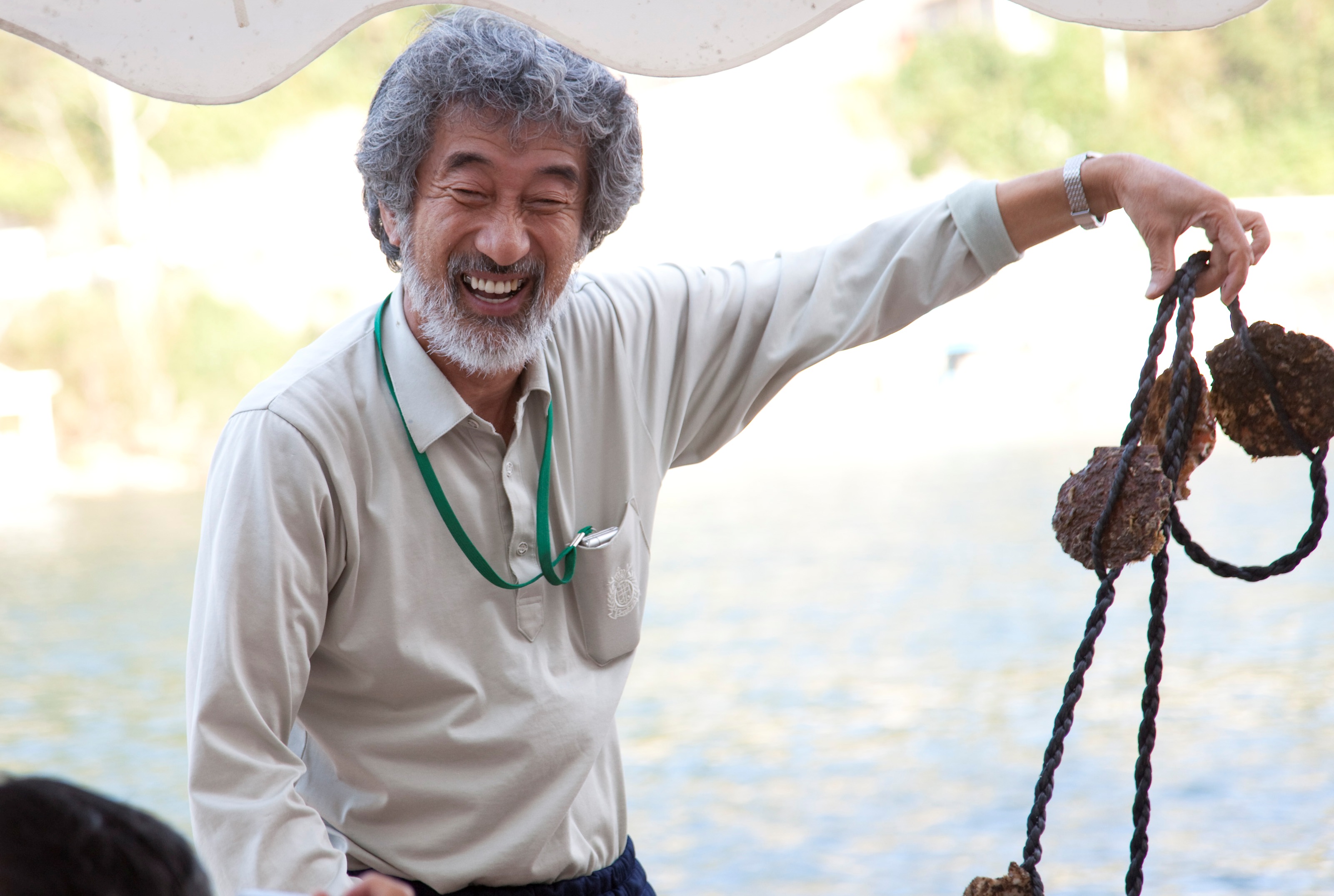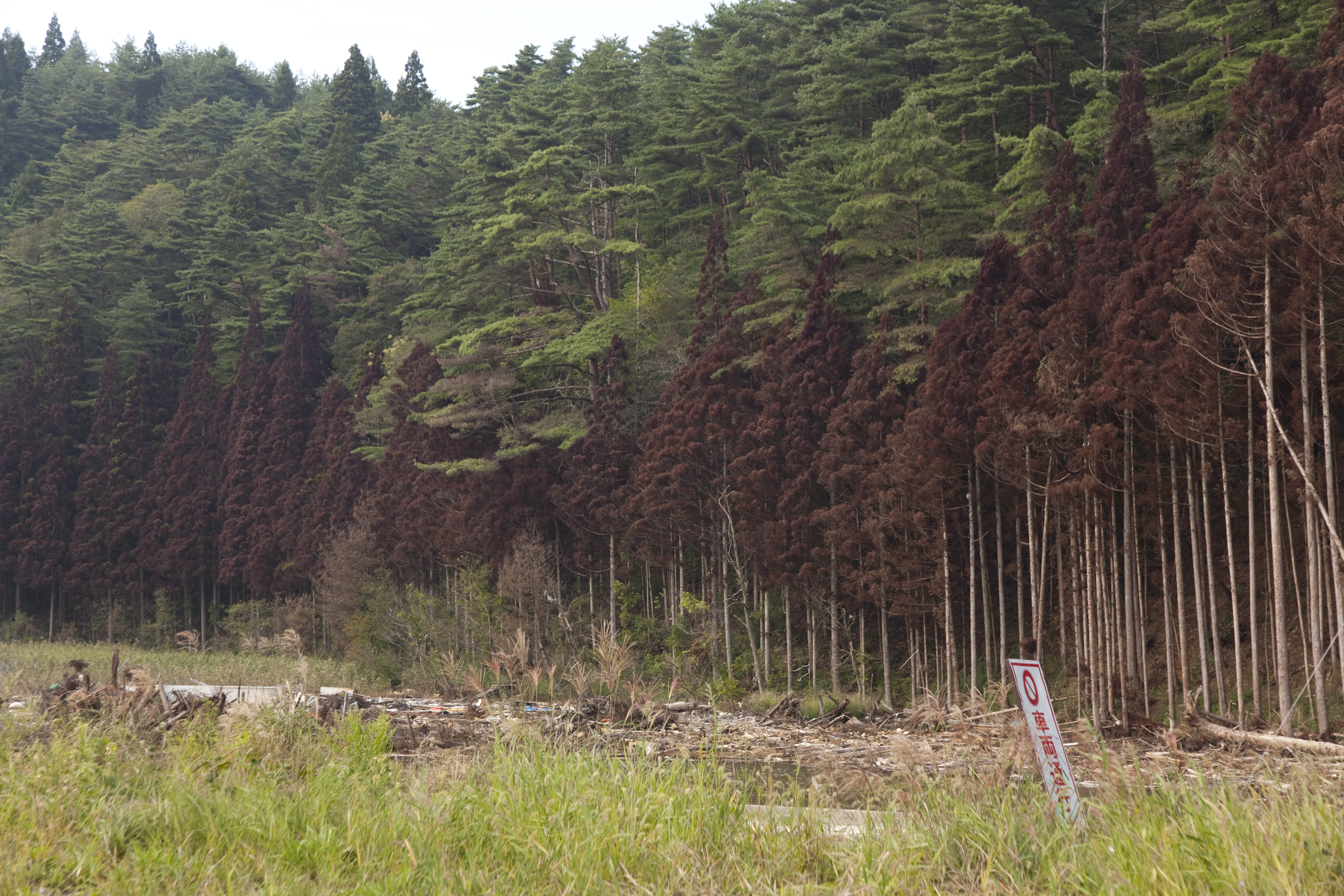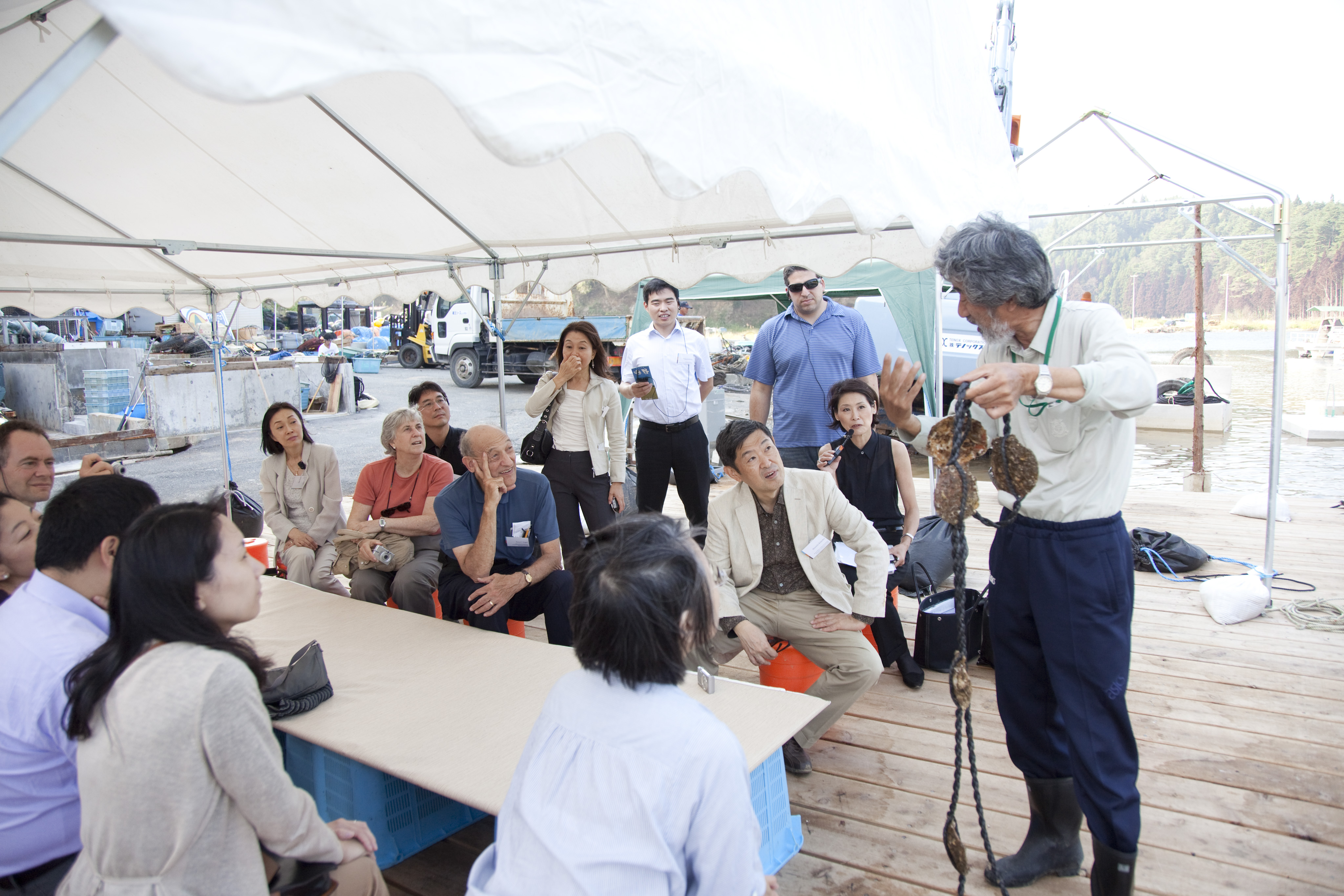- Article
- Other
Waves of Despair, Tides of Hope: Rebuilding Tohoku’s Aquaculture Industry after March 11
February 21, 2012
On September 9, 2011, a group of leading scholars from China, Japan, and the United States toured areas devastated by the March 11 earthquake and tsunami. One stop along the bus tour was a meeting with Shigeatsu Hatakeyama, an oyster fisherman in Kesennuma, Miyagi Prefecture, who is leading an effort to revive oyster farming.
Organized by the Tokyo Foundation, the tour was part of the Tokyo Program of a trilateral symposium on “New Patterns in East Asia and China-Japan-US Relations,” held in Beijing on September 6 in commemoration of the thirtieth anniversary of the Institute of Japan Studies, Chinese Academy of Social Sciences.
Participants in the Tohoku tour included Harvard University Professor Emeritus Ezra Vogel; Li Wei, director of the Institute of Japanese Studies, CASS; Tokyo Foundation Senior Fellow and University of Tokyo Professor Shin’ichi Kitaoka; and Patricia G. Steinhoff, professor of sociology at the University of Hawaii.
The following is the gist of Hatakeyama’s comments.
* * *
Thank you for coming today. I’ve been cultivating oysters here in Kesennuma for about 60 years. Here along the Sanriku coast, people say that two big tsunamis come along during one’s lifetime. So I knew we were due for another one sooner or later.
But I never dreamed it would be this big.
We had a big tsunami fifty years ago after the Chile earthquake. At that time, the waves came up to about here. The rafts offshore were damaged. But there were some we could still use.

This time, everything was washed away. The processing facilities up along the shore, including water tanks, were destroyed. The tsunami swallowed the refrigerators, trucks, and boats. The small boats you see here are donations. This one comes from Mie Prefecture.
Being scholars, you may wonder why we chose to live in such a dangerous place. There used to be 52 houses in this cove, and 44 were washed away. For about two months after the tsunami, everyone said this was too dangerous a place to live. But from around the third month, people again wanted to see the ocean from where they lived—but this time from a little higher up the hill.
The tsunami took everything away, but nobody here—myself included—bears any grudges. Anthropologists have come to study this phenomenon. Virtually no one has any bitter feelings against the sea or the tsunami. That’s because the sea has been such a generous provider until now.
For about two months, the cove was devoid of life. There was not a single fish in the sea. But one day my grandchild said, “Look grandpa, there are tiny fish in there.” Gradually, the waters started filling with life. After the Chile earthquake 50 years ago, the oysters grew much larger. So I knew that the sea becomes richer after a tsunami.
This time, though, because everything disappeared from the waters, I was afraid that the sea had died. You can see that some of the cedars over there have wilted. They were covered by waves, which reached 37 meters above sea level. Even here, water levels rose by around 20 meters. Can you imagine that? Where we’re standing now was like the bottom of the sea. What would happen if such huge waves flooded Tokyo or Osaka?

Seeing the small fish return after about two months, I knew that the sea hadn’t died.
What I’m holding in my hands are “oyster seeds” (pronounced kaki no tane ). They’re not rice snacks (also pronounced kaki no tane ). [ laughter ] What you see on these scallop shells are baby oysters. Since life has returned to the waters, I knew that if we could get hold of seed oysters, we’d be able to start the farm all over again.
I searched around and found that seed oyster farms near the mouth of the Kitakami River in the city of Ishinomaki had largely survived the tsunami. Virtually all cultured oysters around the world, in fact, originally come from Ishinomaki. This is the variety used by cultivators in Seattle, on the West Coast of the United States, France, New Zealand, South Korea, China . . .
There’s a hatchery in a bay called Mangoku-ura, which, miraculously, survived the tsunami. My sons and I decided to give it another try. But to do this required rafts, like those you now see offshore. They’re made of cedar, which grow all around here. So we cut some down and built new rafts.
The spat are tied to a rope and lowered in the water from the rafts. We began this around June. The seeds we placed in June are already this big. They’re really fast growers!
The tsunami was a massive disaster, but I knew that if we could just restart our operations, we’d be okay. Even now we’re building new rafts and sinking more spat.
Besides rafts, we needed boasts. Fortunately, many people provided assistance. That boat came from Amami Oshima, an island near Okinawa, and it was donated by a man whose business in Shanghai was very successful. He read about me in a book, I think. He visited me about a month after the tsunami and presented me with a boat as a gift.
That other boat belonged to a classmate of mine from middle school who was an oyster farmer near here. His house was washed away by the tsunami, and he lost members of his family. He, too, nearly died and felt that he couldn’t go on. He asked me if I would buy the boat from him, and it was just then that the businessman from Amami Oshima came to visit, and he offered to buy the boat for me.
The classmate’s son wanted to continue farming, though, so I asked him to help me out. He now works for me, and he’s a very hard worker.
This row boat was donated by the association of fishing cooperatives in Mie Prefecture.
We had a carpenter here from Kobe, which also experienced a big quake. He was a volunteer, working during the day as a carpenter and using his wages to buy supplies for the victims in Tohoku. He did this for about two months before he came to my house. I asked him to help and he’s been living with us for about two months.
One of the most important things for a fisherman is a pier. Without it, ships can’t dock. So I asked the carpenter to build the pier you’re standing on now. It’s as if he knew you were coming. I wish I could offer you some beer!
Thanks to such generosity, this part of the Sanriku coast is probably ahead of others in terms reconstruction. And no one here is bitter or angry with what happened.
We had a group of researchers from Kyoto University to investigate plankton levels and water quality. If there are heavy metals or other pollutants in the water, the oysters won’t be suitable for eating. They found nothing harmful in the waters. They also discovered that there was an abundance of plankton, on which the oysters and other creatures feed. When the waves die down, you can see so many tiny fish swimming around.
The tsunami took 20,000 lives and was a horrible tragedy. But if we put that aside, it also churned the waters, and that’s not necessarily a bad thing. It can breathe new life into the sea.
We have to brace ourselves against big tsunamis, which we know will come sooner or later, and take steps to survive them. Otherwise we can’t live in a place like this. For my sons, this was their first big tsunami. I’ve been told it was the biggest in a thousand years, so they went through a truly massive one. It was a shock for them.

I’m a second-generation oyster farmer, so my sons are third-generation. I have four grandsons, and if they follow in their dads’ footsteps, they’ll be fourth-generation. My grandsons also experienced the tsunami, so they’ll have an idea of what to do to save their lives. I’ve also been teaching them what they’ll have to do.
With proper effort, we’ll be able to cultivate oysters for generations to come. If my grandsons do become oyster farmers, our family will have been involved in this trade for over a century.
The tiny oysters on this shell will be big enough for eating by around this time next year. I’m thinking of building a stand here where visitors can enjoy freshly caught oysters. So I hope you’ll come again. And please be sure to bring good wine!
The young oysters are lowered in the sea like this. Anywhere from 30 to 50 larvae are attached to each shell, which grows to the size of a bunch of bananas, weighing around 10 kilograms. Each rope has about 30 such clusters.
All you need is just one rope to get 30 clusters of oysters. The seeds themselves aren’t expensive. On top of that, you don’t need any feed or fertilizer. With only one rope, you can grow enough oysters to feed yourself for a year. Growing oysters is a great job!
The problem, though, is that the tide doesn’t provide all the necessary nutrients. The nutrients come from the forest, which the rivers carry with them as they flow into the sea. Without such nutrients, there’ll be no increase in the planktons. That’s one reason I’ve been advocating the planting of new trees in the forest. I’ve been involved in this movement for 23 years.
Question : Do all the baby oysters make their own shells?
Of course! They grow their own shells. There’s almost an unlimited supply of calcium in the sea.
Question: Is there enough higher ground for everyone to move to?
The tops of some of these hills will probably have to be shaved to make room for everyone. We’re asking the government to provide subsidies for this.
Question: Is that really necessary? Aren’t there natural highlands where people can move to?
I’m afraid not. After about three generations—about 90 years—people tend to forget even the most painful of lessons. So they gradually start moving back down along the shore, because it’s more convenient.
Of course, efforts are made to pass the lessons on to future generations. For example, signposts have been erected to warn people not to build houses below a certain point. This time, I think people have really learned their lesson! After all, 20,000 people lost their lives.
We live about 20 meters up the hill from here, so we were safe. My grandfather had the foresight to build a house on high ground. If he had chosen to build closer to the water, I probably wouldn’t be here with you today. (Photos by Seiya Kawamoto)
